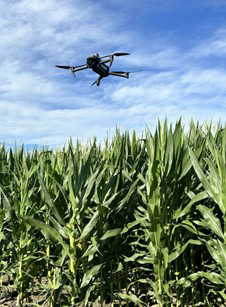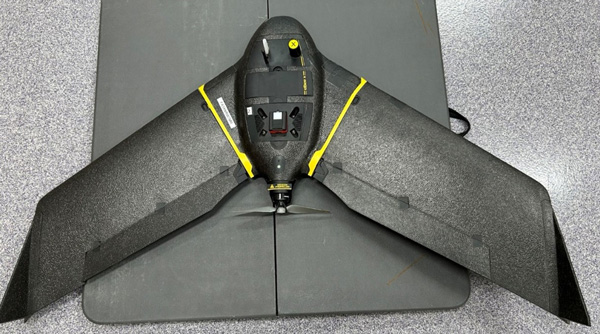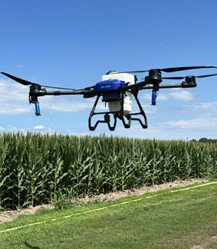Drones are one of the most important precision agriculture tools. With the advancement in drone technology, they are digitizing the agriculture field by enabling data-driven decision-making to increase crop and ranch production, sustainability, and efficiency. Not only do drones provide a bird’s-eye view of our soil, crops, and ranch, but they are also now used in diverse applications such as agricultural operational activities like spraying and seeding. Based on their structure, performance, and roles, agricultural drones can be categorized into different types. There are different types of drones commonly used in precision agriculture.
Multirotor drones
Multirotor drones usually have four to six rotors (Figure 1). These drones are quite popular in agriculture for mapping and spraying purposes. They have hovering capacity, which enables them to hover over a specific area to get detailed information or spray. As these drones usually fly at lower altitudes compared to fixed wings, the images are of higher resolution. Since these drones can take off and land vertically, they might not need too much space for operation. These drones are quite excellent for a small area. However, the battery life of a multirotor drone is about 20 to 45 minutes, making them less practical for larger fields. In addition, they are less stable than a fixed-wing drone in wind conditions.
Modern multirotor drones come with different advanced features such as anti-collision, obstacle detection/ avoidance, Real Time Kinematic (RTK), Post-Processed Kinematic (PPK), and Global Navigation Satellite System (GNSS) features. Based on needs, different sensors such as RGB, multispectral, LiDAR, thermal, and hyperspectral sensors can be mounted on these drones for different purposes.

Figure 1. A multirotor type of drone is collecting imagery over a corn field. Photo by Deepak Joshi, K-State Research and Extension.
Fixed-wing drones
Fixed-wing drones usually have wings, and they look like a small airplane (Figure 2). Usually, these types of drones have greater coverage and better battery life for long flight times. These can be used to survey or map a quarter section (160 acres) of field within 45 minutes or less, depending on wind speed. Moreover, due to better aerodynamic design, these drones can also handle windy conditions better than other types of drones. Fixed-wing drones with multispectral sensors are commonly used for scouting, surveying, field mapping, crop health monitoring, and Irrigation monitoring. The main limitations of these types of drones may be the need for open space for taking off and landing, as these drones usually cannot take off and land vertically. Moreover, these drones also lack hovering capabilities, which will not allow them to hover over a specific part of the field or ranch.
In terms of cost, usually fixed-wing drones are slightly more expensive compared to some other types of drones, but still, the total cost will be different based on the different features present. Many modern fixed-wing drones have different advanced features, such as automated flight planning, which allows automated flight and pre-programmed missions without minimal manual intervention. Some other safety features might be geofencing, which can define no-fly zones by creating boundaries around the field, as well as altitude limits to prevent drones from entering restricted airspace and reduce the chances of losing drones. In addition to that, Real Time Kinematic (RTK) and Post-Processed Kinematic (PPK) and Global Navigation Satellite System (GNSS) features in drones also ensure high-accuracy geolocation, ensuring flight stability through precise positioning.

Figure 2. A fixed-wing imaging drone. Photo by Deepak Joshi, K-State Research and Extension.
Hybrid drones
Hybrid drones have the features of both fixed-wing and multirotor drones. Due to these combined features, these drones can perform more efficiently as well as precisely. These drones are ideal for mid to large-sized fields. However, compared to other drones, they are comparatively less common in the agricultural field.
Operational drones
These drones are more specialized for agricultural operational activities such as spraying pesticides, herbicides, or seeding. These drones can be found in both fixed-wing (Figure 3a) and multirotor types (Figure 3b). Usually, fixed-wing operational drones have larger coverage areas and longer battery life. Multirotor operational drones can hover over specific areas of crops and ranches to spray and seed more precisely. Spot treatment for weeds or diseases is possible using spray drones.
These operational drones have multiple benefits due to precision application, less or minimal drift, they can reach difficult-to-reach areas or wet soil condition areas, and are also considered time and cost saving compared to other spraying methods. However, the overall effectiveness of the spray with these drones depends on various factors, including flight altitude, flight speed, wind speed/direction, temperature, nozzle types, droplet size, spray liquid properties, etc. Moreover, limited battery life and payload capacity might limit their operation for larger fields.

Figure 3a. Fixed-wing spraying drone. Photo by Deepak Joshi, K-State Research and Extension.

Figure 3b. Multi-rotor spraying drone. Photo by Deepak Joshi, K-State Research and Extension.
Conclusion
Drones are now transforming the agriculture sector and are used for various purposes, including field scouting, mapping, surveying, and operational activities. These drones are of different types, and each has its own strengths and weaknesses. By understanding these different types of drones, growers and agronomists can best determine which drone meets their needs. Regardless of the type of drone, it is important to follow all Federal Aviation Administration (FAA) rules and regulations to ensure safe and legal drone operations.
Deepak Joshi, Precision Ag Extension Specialist
drjoshi@ksu.edu
Jeremie Kouame, Weed Scientist – Hays
jkouame@ksu.edu
Sarah Lancaster, Weed Science Extension Specialist
slancaster@ksu.edu